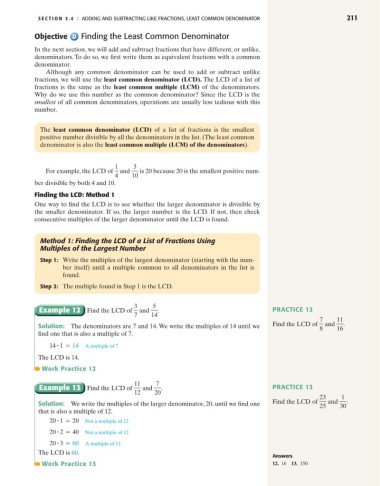Page 234 - Basic College Mathematics with Early Integers
P. 234
S E C T I O N 3.4 I ADDING AND SUBTRACTING LIKE FRACTIONS, LEAST COMMON DENOMINATOR 211
Objective Finding the Least Common Denominator
In the next section, we will add and subtract fractions that have different, or unlike,
denominators. To do so, we first write them as equivalent fractions with a common
denominator.
Although any common denominator can be used to add or subtract unlike
fractions, we will use the least common denominator (LCD). The LCD of a list of
fractions is the same as the least common multiple (LCM) of the denominators.
Why do we use this number as the common denominator? Since the LCD is the
smallest of all common denominators, operations are usually less tedious with this
number.
The least common denominator (LCD) of a list of fractions is the smallest
positive number divisible by all the denominators in the list. (The least common
denominator is also the least common multiple (LCM) of the denominators).
1 3
For example, the LCD of and is 20 because 20 is the smallest positive num-
4 10
ber divisible by both 4 and 10.
Finding the LCD: Method 1
One way to find the LCD is to see whether the larger denominator is divisible by
the smaller denominator. If so, the larger number is the LCD. If not, then check
consecutive multiples of the larger denominator until the LCD is found.
Method 1: Finding the LCD of a List of Fractions Using
Multiples of the Largest Number
Step 1: Write the multiples of the largest denominator (starting with the num-
ber itself) until a multiple common to all denominators in the list is
found.
Step 2: The multiple found in Step 1 is the LCD.
3 5
Example 12 Find the LCD of and . PRACTICE 12
7 14
7 11
Solution: The denominators are 7 and 14. We write the multiples of 14 until we Find the LCD of and .
8 16
find one that is also a multiple of 7.
#
14 1 = 14 A multiple of 7
The LCD is 14.
Work Practice 12
11 7
Example 13 Find the LCD of and . PRACTICE 13
12 20
23 1
Solution: We write the multiples of the larger denominator, 20, until we find one Find the LCD of 25 and 30 .
that is also a multiple of 12.
#
20 1 = 20 Not a multiple of 12
#
20 2 = 40 Not a multiple of 12
#
20 3 = 60 A multiple of 12
The LCD is 60.
Answers
Work Practice 13 12. 16 13. 150

